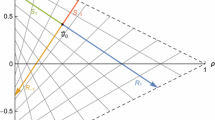Abstract
We consider classical hard-core particles hopping stochastically on two parallel chains in the same or opposite directions with an inter- and intra-chain interaction. We discuss general questions concerning elementary excitations in these systems, shocks and rarefaction waves. From microscopical considerations we derive the collective velocities and shock stability conditions. The findings are confirmed by comparison to Monte Carlo data of a multi-parameter class of simple two lane driven diffusion models, which have the stationary state of a product form on a ring. Going to the hydrodynamic limit, we point out the analogy of our results to the ones known in the theory of differential equations of two conservation laws. We discuss the singularity problem and find a dissipative term that selects the physical solution.
Similar content being viewed by others
REFERENCES
G. M. Schütz, Exactly solvable models for many-body systems far from equilibrium, in Phase Transitions and Critical Phenomena, Vol. 19, C. Domb and J. Lebowitz, eds. (Academic Press, London, 2000).
J. Krug, Boundary-induced phase transitions in driven diffusive systems, Phys. Rev. Lett. 67:1882-1885 (1991).
M. R. Evans, D. P. Foster, C. Godrèche, and D. Mukamel, Symmetric exclusion model with two species: Spontaneous symmetry breaking, J. Stat. Phys. 80:69-102 (1995).
F. Rezakhanlou, Hydrodynamic limit for attractive particle systems in Zd, Comm. Math. Phys. 140:417-448 (1991).
M. V. Freore, H. Guiol, K. Ravishankar, and E. Saada, Microscopic structure of the step exclusion process, Bull. Braz. Math. Soc. 33:25-45 (2002).
A. B. Kolomeisky, G. M. Schütz, E. B. Kolomeisky, and J. P. Straley, Phase diagram of one-dimensional driven lattice gases with open boundaries, J. Phys. A 31:6911-6921 (1998).
V. Popkov and G. M. Schütz, Steady-state selection of driven diffusive systems with open boundaries, Europhys. Lett. 48:257-263 (1999).
B. Tóth and B. Valkó, to be published.
V. Popkov and I. Peschel, Symmetry breaking and phase coexistence in a driven diffusive two-channel system, Phys. Rev. E 64:026126(2001).
B. Derrida, S. A. Janowsky, J. L. Lebowitz, and E. R. Speer, Exact solution of the totally asymmetric simple exclusion process: Shock profiles, J. Stat. Phys. 73:813-842 (1993).
B. Derrida, M. R. Evans, V. Hakim, and V. Pasquier, Exact solution of a 1D asymmetric exclusion process using a matrix formulation, J. Phys. A 26:1493(1993); G. Schütz and E. Domany, Phase transitions in an exactly soluble one-dimensional exclusion process, J. Stat. Phys. 72:277-297 (1993).
T. M. Liggett, Stochastic Interacting Systems: Contact, Voter and Exclusion Processes (Springer, Berlin, 1999).
D. Serre, Systems of Conservation Laws (Cambridge University Press, 1999).
P. D. Lax, Hyperbolic Systems of Conservation Laws and the Mathematical Theory of Shock Waves (Society for Industrial and Applied Mathematics, Philadelphia, PA, 1973).
Author information
Authors and Affiliations
Rights and permissions
About this article
Cite this article
Popkov, V., Schütz, G.M. Shocks and Excitation Dynamics in a Driven Diffusive Two-Channel System. Journal of Statistical Physics 112, 523–540 (2003). https://doi.org/10.1023/A:1023819807616
Issue Date:
DOI: https://doi.org/10.1023/A:1023819807616




